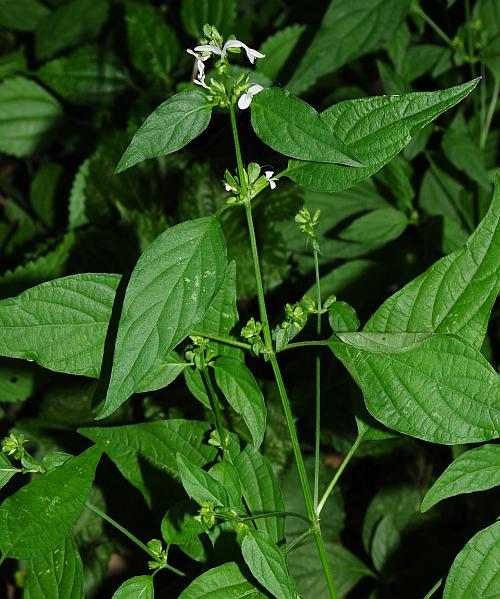Dicliptera brachiata Spreng.
Branched Foldwing

Native
CC = 6
CW = -3
MOC = 32
© SRTurner
Dicliptera brachiata Spreng.Branched Foldwing | |
 |
Native CC = 6 CW = -3 MOC = 32 |
© SRTurner |
|
Family - Acanthaceae Habit - Annual forb. Stem - Ascending to erect, to 80 cm, often angled, usually branched, glabrous or hairy.
Leaves - Opposite, simple, petiolate. Petioles 1-7 cm long. Blades 5-12 cm long, elliptic to ovate, usually tapered at the tip and base, the margins hairy and entire or nearly so, the surfaces sparsely hairy.
Inflorescences - Few-flowered axillary clusters toward the branch tips, subtended by reduced leaves, sometimes appearing as short spikes, the inflorescence stalk usually absent or nearly so, much shorter than the petiole of the subtending leaf. Flowers subtended by bracts 6-10 mm long, these longer than the calyx, oblong to obovate with rounded tips.
Flowers - Calyces 4-6 mm long, deeply lobed, the lobes 2-4 mm long, narrowly lanceolate, long-tapered at the tip, glabrous or hairy along the margins. Corollas 11-15 mm long, the tube 4-6 mm long, strongly 2-lipped, the lips usually with 1 or 2 shallow notches at the tip, hairy on the outer surface, at least when young, pink (drying purple) or less commonly white, the lower lip often with purple spots. Stamens 2, the anther sacs spreading. Staminodes 2, linear, inconspicuous, and hidden in the corolla tube.
Fruits - Capsules 4-6 mm long, 2-valved, elliptic to broadly ovate, flattened, the valves spreading after dehiscence. Seeds 2 or 4, 2.0-2.5 mm long, broadly ovate to circular in outline, flattened, the surface with numerous small spines, reddish brown to black. Flowering - August - October. Habitat - Bottomland forests, streambanks, moist depressions. Origin - Native to the U.S. Lookalikes - None close when flowering. Other info. - The photos on this page show a white-flowered form of this species. More commonly, the flowers are pink to lavender. The plant grows in the southern half of Missouri, somewhat more commonly in the western portion of the state. Its distribution in the continental U.S. is largely confined to the southeastern quadrant of the country. Photographs taken at Route 66 State Park, St. Louis County, MO, 9-3-2019 (SRTurner). |